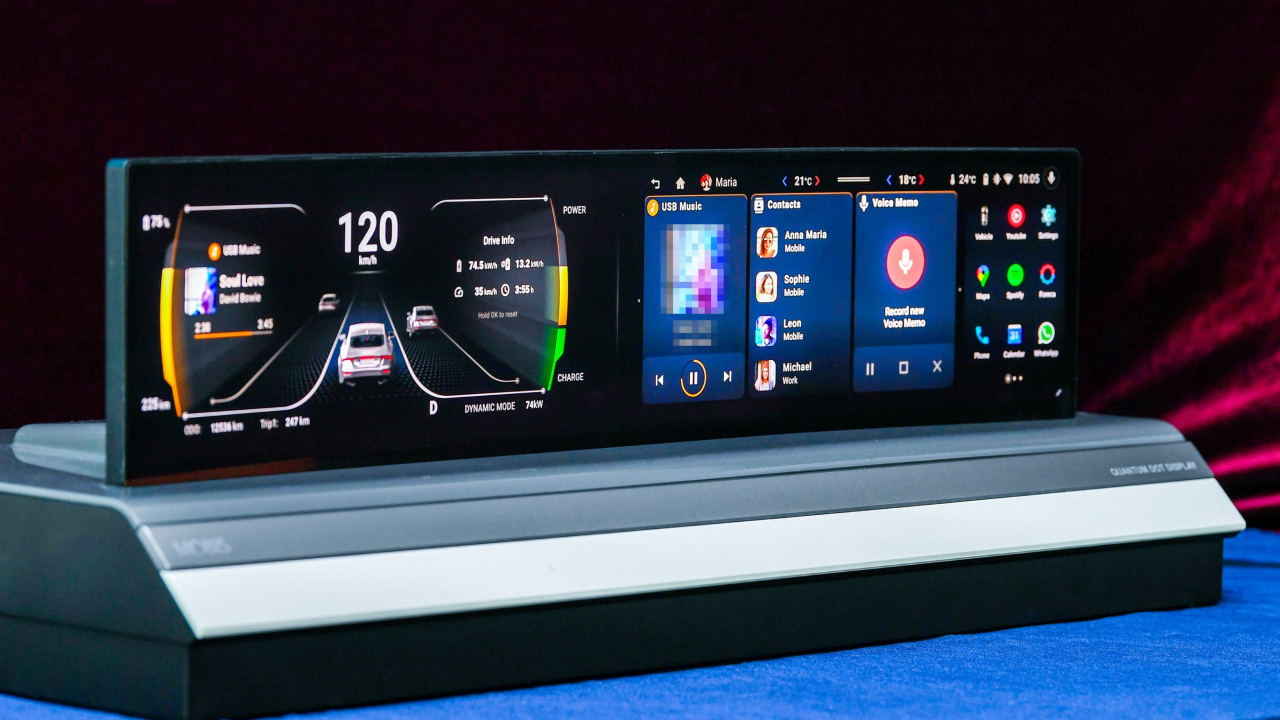 |
Hyundai Mobis’s new quantum dot automotive display with local dimming technology, a 27-inch pillar-to-pillar curved screen that reduces glare with dynamic backlight control. (Hyundai Mobis) |
Hyundai Mobis, a South Korean auto parts maker affiliated with Hyundai Motor Group, unveiled on Thursday that it has developed the world's first quantum dot display for automobiles with local dimming technology, offering a lower-cost alternative to organic light-emitting diode displays commonly found in luxury vehicles.
It marks Hyundai Mobis' entry into the high-end automotive display arena, positioning its quantum dot innovation as a challenger to pillar-to-pillar OLED display formats that span the full width of the driver and passenger dashboard.
Hyundai Mobis’ new display boasts a 27-inch large curved screen with a slim profile of 14.5 millimeters, which can be reduced to 10 mm to accommodate different customer requirements, ensuring a seamless fit within various vehicle interiors.
By integrating quantum dot color technology with local dimming capabilities, the company claims it has enhanced color quality, contrast ratio and glare reduction — rivaling the performance of OLED at a lower price point.
Local dimming, commonly found in quantum dot light-emitting diode TVs, allows dynamic backlight control in segmented zones to increase contrast and achieve truer blacks in each area of an image. This is especially important for automotive displays, where minimizing glare and maintaining clear visibility are essential for driver safety.
“Adapting quantum dot display technology -- a mainstay in consumer electronics like TVs -- for automotive use required significant custom engineering. For example, we had to ensure durability and performance under extreme conditions, as quantum dots can lose efficiency and stability at high temperatures,” said a Hyundai Mobis spokesperson.
OLED and quantum dot technologies are leading the charge in premium display applications across various devices, including TVs, smartphones and laptops. QLEDs are lauded for their brightness and cost-efficiency, particularly in TVs and monitors. In contrast, OLEDs are known for their high contrast ratio, slim design and energy efficiency, making them popular in smartphones and luxury automotive displays.
Although QLEDs offer several advantages, they have fallen short of OLEDs in offering wide viewing angles and achieving perfect black tones due to its reliance on a layer of quantum dots for illumination, unlike an OLED's capacity to light each pixel independently.
Automotive displays that can achieve perfect black tones not only improve visibility but also allows for a more aesthetically pleasing integration with the car's interior.
This is why OLED has been the preferred choice for high-end car displays, such as LG Display's flexible OLED panel in the Mercedes EQS Hyperscreen and the pillar-to-pillar display in the 2024 Genesis GV80, which launched this October with a panoramic 27-inch OLED display -- a first in Hyundai's vehicle lineup.
Hyundai Mobis is positioning its new quantum dot automotive display to help facilitate broader adoption of pillar-to-pillar display formats.
The company plans to introduce this new technology to potential automotive clients in North America and Europe, targeting major showcases at international events like the Consumers Electronics Show.






![[Weekender] Korea's traditional sauce culture gains global recognition](http://res.heraldm.com/phpwas/restmb_idxmake.php?idx=644&simg=/content/image/2024/11/21/20241121050153_0.jpg)
